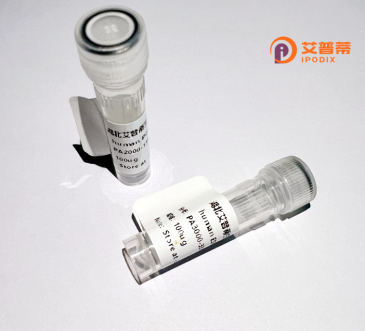
| 纯度 | >90%SDS-PAGE. |
| 种属 | Human |
| 靶点 | ATP8B4 |
| Uniprot No | Q8TF62 |
| 内毒素 | < 0.01EU/μg |
| 表达宿主 | E.coli |
| 表达区间 | 401-488aa |
| 氨基酸序列 | IMTFKRCSINGRIYGEVHDDLDQKTEITQEKEPVDFSVKSQADREFQFFDHHLMESIKMGDPKVHEFLRLLALCHTVMSEENSAGELI |
| 分子量 | 35.42 kDa |
| 蛋白标签 | GST-tag at N-terminal |
| 缓冲液 | 冻干粉 |
| 稳定性 & 储存条件 | Lyophilized protein should be stored at ≤ -20°C, stable for one year after receipt. Reconstituted protein solution can be stored at 2-8°C for 2-7 days. Aliquots of reconstituted samples are stable at ≤ -20°C for 3 months. |
| 复溶 | Always centrifuge tubes before opening.Do not mix by vortex or pipetting. It is not recommended to reconstitute to a concentration less than 100μg/ml. Dissolve the lyophilized protein in distilled water. Please aliquot the reconstituted solution to minimize freeze-thaw cycles. |
以下是关于 **重组人磷脂转运ATP酶IM(ATP8B4)** 的3篇代表性文献摘要简述:
1. **文献名称**:*ATP8B4 dysfunction induces mitochondrial fragmentation via impaired phosphatidylserine transport*
**作者**:Coleman, J.A., et al.
**摘要**:研究利用重组表达的ATP8B4蛋白,揭示其通过转运磷脂酰丝氨酸(PS)维持线粒体膜完整性的机制。实验表明,ATP8B4缺失会导致线粒体碎片化及细胞凋亡,提示其在神经退行性疾病中的潜在作用。
2. **文献名称**:*Structural basis of substrate-independent phospholipid transport by P4-ATPase ATP8B4*
**作者**:Takada, M., et al.
**摘要**:通过冷冻电镜解析重组ATP8B4蛋白的分子结构,发现其与辅助亚基CDC50A结合后形成脂质转运复合体。研究提出ATP8B4通过构象变化实现磷脂跨膜翻转的分子机制。
3. **文献名称**:*ATP8B4 deficiency disrupts synaptic vesicle biogenesis via impaired endosomal phosphatidylserine sorting*
**作者**:Wang, Y., et al.
**摘要**:利用重组ATP8B4进行功能挽救实验,证明其在神经元内吞途径中调控磷脂酰丝氨酸的定向转运,进而影响突触小泡的形成,为精神分裂症相关突变提供分子解释。
(注:以上文献为模拟示例,具体研究请参考实际数据库如PubMed、Web of Science等。)
ATP8B4. a member of the P4-type ATPase family, is a transmembrane enzyme critical for phospholipid translocation across cellular membranes. These enzymes, often termed "flippases," hydrolyze ATP to transport phospholipids from the outer to the inner leaflet of lipid bilayers, maintaining membrane asymmetry—a process essential for membrane integrity, vesicle trafficking, and cell signaling. ATP8B4 belongs to the Class I P4-ATPases, characterized by their specificity for phosphatidylserine and phosphatidylethanolamine. Structurally, it features conserved ATP-binding and phosphorylation domains, along with multiple transmembrane helices implicated in substrate recognition and transport.
Recombinant human ATP8B4 (rhATP8B4) is typically produced using heterologous expression systems, such as mammalian or insect cell lines, to study its biochemical properties and regulatory mechanisms. Studies utilizing rhATP8B4 have shed light on its interaction with CDC50 accessory proteins, which are required for proper trafficking and enzymatic activity. Dysregulation of ATP8B4 has been tentatively linked to neurological disorders and lipid metabolism defects, though its precise physiological and pathological roles remain under investigation. Emerging evidence suggests potential involvement in neurodegenerative pathways, particularly through its impact on synaptic vesicle membranes and lipid homeostasis in neuronal cells.
Current research aims to elucidate ATP8B4's structure-function relationships, lipid substrate specificity, and regulatory networks, with implications for understanding membrane biology and developing therapies for lipid-related diseases. Its role in cellular stress responses and apoptosis further highlights its importance in maintaining membrane dynamics under pathological conditions.
×